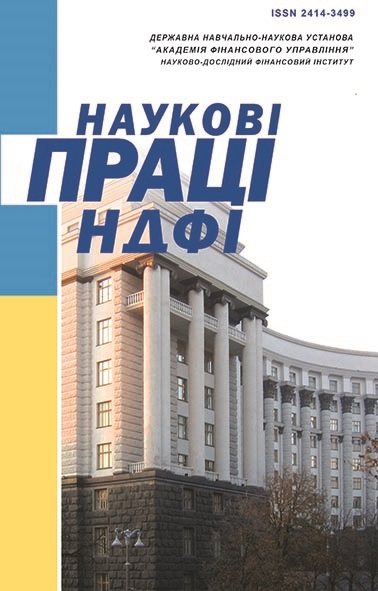
|
№ 4/2017№ 4/2017 | Nauk. pr. NDFI 2017 (4): 143–156https://doi.org/10.33763/npndfi2017.04.143 | ACCOUNTING AND TAXATION RAINOVA Larysa 1 1SESE "The Academy of Financial Management"
OrcID ID : https://orcid.org/0000-0002-8275-3094
Experience of approximation of Poland’s tax legislation to EU directives
The article analyzes the list of key measures implemented by Poland during 1997-2003 to ensure the adaptation of the legislation on indirect taxation to the provisions of acquis cоmmunautaire. The urgency of recearch of experience of EU countries, especially post-socialist ones, on the specified questions is caused by necessity of the further correction of the provisions of the national legislation in accordance with the commitments made within the framework of the Association Agreement between Ukraine and the EU. The purpose of the work was to identify the problematic issues that had to be solved during the process of harmonization of the legislation on indirect taxation in Poland, to study of the degree of fulfillment of the commitments undertaken by the country within the established timeframes and the results of the work carried out at the time of its accession to the EU. To solve the problems posed in the article, methods of factor analysis, comparative and structural analysis were used. It has been established that the process of harmonizing the legislation on indirect taxation with the regulatory requirements of acquis proved to be rather difficult and long-term, and should have been extended after the accession of Poland to the EU. The result of numerous negotiations was the agreement of its parties transition periods, as well as number of deviations to ensure further approximation of the legislation of the country on indirect taxation to EU standards. It is substantiated that the main constraint for faster progress of necessary reforms was the level of indirect tax burden, which had to be established according to the acquis cоmmunautaire, rather high given the economic and social implications of the introduction of relevant legislative changes. It has been proved that the greatest difficulties with the harmonization of the legislation of the country in sphere of VAT as a whole were related to the availability of too wide a list of tax privileges (in the form of reduced and zero rates, as well as additional to the standard exemptions) incompatible with the list of permitted in accordance with the EU regulatory requirements privileges, hence the tax base turned out to be much narrower; the level of standard rates, on the contrary, was on average even higher than the corresponding level of standard rates in the EU-15 countries. The problems in the field of excise taxation were mainly related with the rates of excise duties, primarily in terms of taxation of tobacco products and energy, as well as the introduction of a duty suspension arrangement and a system of tax warehouses; bringing in the structure of excise duties in accordance with the current standards, as a rule, did not cause particular difficulties. It is concluded that taking into account the economic and social consequences of applying certain measures in the framework of harmonization of taxes which may prove to be quite contradictory, as evidenced by the experience of the post-socialist countries of the EU, is a priority in terms of the timing of the necessary changes to the national legislation. The existence of such consequences served as the basis for appeals from the EU countries to grant them the right to apply longer transition periods or the application of derogations. Keywords:tax harmonization, VAT, excise tax, transitional periods, derogations JEL: Н22, Н71, Н87
RAINOVA L. . Experience of approximation of Poland’s tax legislation to EU directives / L. . RAINOVA // Наукові праці НДФІ. - 2017. - № 4. - C. 143-156. | Article original in Ukrainian (pp. 143 - 156) | Download | Downloads :281 |
1. Iefymenko, T. (2014). Actual problems of modern strategies of tax system reforming. Finance of Ukraine, 1, 105–122.
2. Kry`sovaty`j, A. I., Valihura, V. A. (2010). Dominances for tax harmonization: national and international vectors. Ternopil`: Pidruchny`ky` i posibny`ky` [in Ukrainian].
3. Kry`sovaty`j, A. I., Mel`ny`k, V. M. & Koshhuk, T. V. (2014). Tax transformations in the EU and Ukraine’s tax policy in the context of European integration. Ternopil`: TNEU [in Ukrainian].
4. Bilec`ka, H. M., Karmalita, M. V. & Kuc, M. O. et al. (2012). Harmonization of tax legislation: Ukrainian realities. Ky`yiv: Alerta [in Ukrainian].
5. Korotun, V. I. (Ed.). (2015). Transformation of the excise policy of Ukraine. Irpin`: Vy`davny`ctvo Nacional`noho universy`tetu DPS Ukrayiny` [in Ukrainian].
6. Sokolovs`ka, A. M. (2016). Ways of convergence of chapter V of the Tax Code of Ukraine and Council Directive 2006/112/EC. Finance of Ukraine, 8, 59–88 [in Ukrainian].
7. Kulawczuk, P., Bąk, M. & Szcześniak, A. (n. d.). Impact of Tax Harmonization with EU on Economies of Central European Countries during the Pre-Accession Period. Retrieved from www.cerge-ei.cz/pdf/gdn/rrc/RRCIV_15_paper_02.pdf.
8. Ott, K. (2008). The Tax Alignment Process in the New European Union Member States: How Might Croatia Fare? Journal of Applied Law and Policy, pp. 81–97. Retrieved from bib.irb.hr/datoteka/364868.ott.pdf.
9. Kohlhaas, M., Schumacher, K. & Diekmann, J. et al. (2004). Economic, Environmental and International Trade Effects of the EU Directive on Energy Tax Harmonization. German Institute for Economic Research Discussion Paper, 462. Retrieved from ecomod.net/sites/default/files/document-conference/ecomod2004/301.pdf.
10. Karolak, A. (2011). Adaptation Process of a Polish Tax Law to European Union Norms - Harmonization of a Value Added Tax. Economics & Sociology, Vol. 4, No. 1, 54-63.
doi.org/10.14254/2071-789X.2011/4-1/6
11. Lenain, P., Bartoszuk, L. (2000, March). The Polish Tax Reform. OECD Economics Department Working Papers, 234. Retrieved from www.oecd-ilibrary.org/docserver/download/5lgsjhvj81r5.pdf?expires=1460361561&id=id&accname=guest&checksum=29C8D836514BB5E30730A02F4526AF41.
12. Commission of the European Communities. (1998). Regular Report from the Commission on Poland’s Progress towards Accession. Retrieved from ec.europa.eu/enlargement/archives/pdf/key_documents/1998/poland_en.pdf.
13. Commission of the European Communities. (1999, October 13). 1999 Regular Report from the Commission on Poland’s Progress towards Accession. Retrieved from ec.europa.eu/enlargement/archives/pdf/key_documents/1999/poland_en.pdf.
14. Commission of the European Communities. (2000, November 8). 2000 Regular Report from the Commission on Poland’s Progress towards Accession. Retrieved from ec.europa.eu/enlargement/archives/pdf/key_documents/2000/pl_en.pdf.
15. Council of Ministers of the Republic of Poland. (2001). Poland’s negotiation position in the area of taxation. Retrieved from abm.tobb.org.tr/hdosya/polonya%2010.pdf.
16. Commission of the European Communities. (2001, November 13). 2001 Regular Report on Poland’s Progress towards Accession. Retrieved from ec.europa.eu/enlargement/archives/pdf/key_documents/2001/pl_en.pdf.
17. Commission of the European Communities. (2002, October 9). 2002 Regular Report on Poland’s Progress towards Accession. Retrieved from ec.europa.eu/enlargement/archives/pdf/key_documents/2002/pl_en.pdf.
18. Commission of the European Communities. (2003, November 5). Comprehensive monitoring report on Poland’s preparation for membership 2003. Retrieved from aei.pitt.edu/44596/1/poland_SEC_(2003)_1207.pdf.
19. Appel, H. (2011). Tax Politics in Eastern Europe: Globalization, Regional Integration, and the Democratic Compromise. University of Michigan Press.
doi.org/10.3998/mpub.2101103
|





